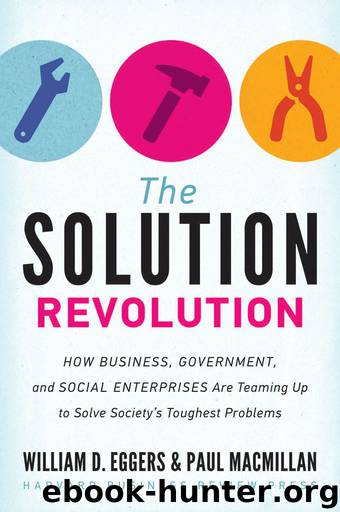The Solution Revolution: How Business, Government, and Social Enterprises Are Teaming Up to Solve Society's Toughest Problems by William D. Eggers & Paul Macmillan

Author:William D. Eggers & Paul Macmillan
Language: eng
Format: mobi
Publisher: Harvard Business Review Press
Published: 2013-08-26T14:00:00+00:00
SIX
The Ecosystems
Converging around big, hairy, audacious problems
In traditional business thinking, a company discovers an unmet demand and brings a solution to market. But what if there were no demand? And no market? And your potential customers were literally dirt poor? Traditional thinking would tell you to give up.
In the solution economy, the winning approach is to capitalize on your role in a broader ecosystem. If a problem exists, the answer is to create an environment in which the solution can organically, sustainably, profitably be brought to bear—even if there is no market demand in the traditional sense. Sound impossible? Well, that’s exactly what Unilever did in India to address a critical public sanitation problem. How the company did it demonstrates the role that ecosystems play in the solution revolution.
Sometimes the best solution is as simple as a bar of soap. Diarrhea kills 1.5 million children a year worldwide, making it the second-most common cause of death for children under five. Yet the remedy has been known for centuries: basic sanitation practices such as hand washing cut the risk of contracting the disease in half. The usefulness of soap in this regard was understood as far back as in ancient Babylon.1
Remarkably, though, perhaps a billion of the world’s poorest inhabitants do without this most basic of essentials. For many, soap doesn’t fit their budget (about 1.2 billion people earn less than $1 a day), and many others are unaware of soap’s sanitizing properties and critical role in hygiene.2
These consumers occupy what business strategists C. K. Prahalad and Stuart L. Hart call the bottom, or base, of the global economic pyramid.3 As discussed earlier, conventional businesses historically neglected the needs of those at the base of the pyramid, unless the companies were selling supplies to humanitarian relief organizations. It was considered impossible to serve remote, impoverished regions without taking a sharp financial loss. In many cases, the basic market features wealthier societies take for granted—grocery stores, pharmacies, and other retail outlets for hygiene products—simply don’t exist. In addition, the special needs of this consumer population had never been researched by the marketing department.
Into this market void stepped HUL, Unilever’s subsidiary in India (hereafter known simply as Unilever). Over the years, Unilever has become one of the most sophisticated companies in the world in selling to the poor, employing a host of strategies in many countries to reach this very hard-to-reach market segment. In the case of providing soap in India’s rural villages, Unilever recognized a blue-ocean opportunity, that is, an opportunity to serve a huge, untapped market. In 2000, the company revamped its business strategy to accommodate this opportunity. To reach the potential market of more than 600 million low-income Indians, Unilever would have to create an entire ecosystem. Because its product would address a serious public health issue, it was able to partner with NGOs, banks, and schools to create a market for cleaning products in rural India—while lifting women from poverty with microloans and jobs, improving public health and sanitation, and enhancing public health awareness through educational campaigns—all while turning a profit.
Download
This site does not store any files on its server. We only index and link to content provided by other sites. Please contact the content providers to delete copyright contents if any and email us, we'll remove relevant links or contents immediately.
| Anthropology | Archaeology |
| Philosophy | Politics & Government |
| Social Sciences | Sociology |
| Women's Studies |
The Secret History by Donna Tartt(18797)
The Social Justice Warrior Handbook by Lisa De Pasquale(12117)
Thirteen Reasons Why by Jay Asher(8762)
This Is How You Lose Her by Junot Diaz(6745)
Weapons of Math Destruction by Cathy O'Neil(6110)
Zero to One by Peter Thiel(5657)
Beartown by Fredrik Backman(5571)
The Myth of the Strong Leader by Archie Brown(5395)
The Fire Next Time by James Baldwin(5220)
How Democracies Die by Steven Levitsky & Daniel Ziblatt(5107)
Promise Me, Dad by Joe Biden(5067)
Stone's Rules by Roger Stone(5007)
A Higher Loyalty: Truth, Lies, and Leadership by James Comey(4819)
100 Deadly Skills by Clint Emerson(4818)
Rise and Kill First by Ronen Bergman(4676)
Secrecy World by Jake Bernstein(4615)
The David Icke Guide to the Global Conspiracy (and how to end it) by David Icke(4595)
The Farm by Tom Rob Smith(4415)
The Doomsday Machine by Daniel Ellsberg(4390)
